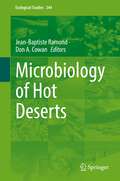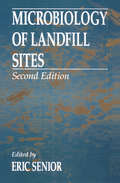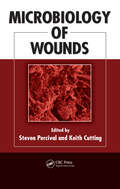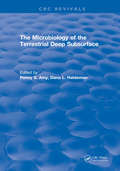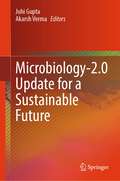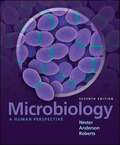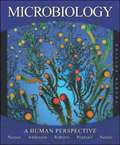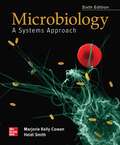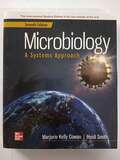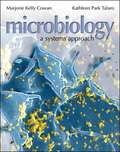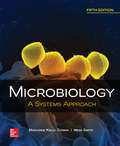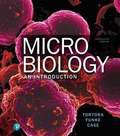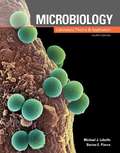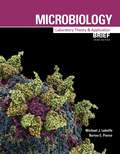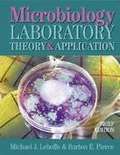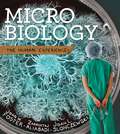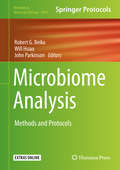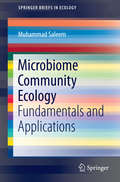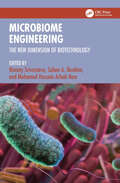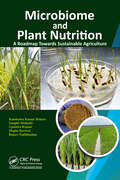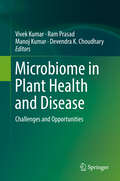- Table View
- List View
Microbiology of Hot Deserts (Ecological Studies #244)
by Don A. Cowan Jean-Baptiste RamondThis book covers the wider aspects of the microbiology of hot desert soil ecosystems, compiling disparate information from a range of relevant desert soil microbial fields.The reader learns about microbial ecology of the more dominant and possibly most important desert habitats, detailing the phylogenetic and functional diversity of these different habitats as well as their potential role in desert ecosystem ecology. Particular attention is also given to microbial stress adaptation in hot desert soils. Furthermore, it is the first volume in this particular field to cover modern metagenomics technologies that can be applied to studies of all aspects of desert microbial communities. Additionally, the book explores viruses and viral communities, which are among the least studied (and little understood) components of desert soil microbial communities. Particular attention is also given to the roles of desert microbial communities in biogeochemical cycling of carbon, nitrogen and phosphorus. Through this book the reader discovers how desert microbiology has been at the forefront of Astrobiology and how it may be used conceptually in future terraforming strategies. Desert ecosystems are increasingly coming into focus given the impacts of climate change and desertification trends, making this volume particularly timely. Each of the chapters is authored by leading international researchers and is a must-read for microbial ecologists.
Microbiology of Landfill Sites
by Eric SeniorThis book was originally published in 1990 and was the first text to consider the definitive fundamental science of landfill biotechnology. Since then, major research initiatives, particularly in the U.K. and South Africa, have resulted in considerable advancement in our knowledge of landfill microbiology. The Second Edition details this progress. Text considers the latest findings in landfill leachate treatment, co-disposal and fundamental microbiology. It brings together the expertise of the immediate complementary, but often disparate disciplines of soil science, environmental engineering, applied mathematics, and land reclamation and focuses on the common goal of the scientific design and management of landfill sites. The book also includes effective laboratory models and selected approaches.
Microbiology of Wounds
by Steven Percival Keith CuttingIt is not the presence of microorganisms, but their interaction with patients that determines their influence on wound healing. Documenting this critical but often ignored aspect of the treatment process, Microbiology of Wounds discusses the microbiology and biology of human wounds in relation to infection and non-healing. Gain the Necessary Scient
Microbiology of the Terrestrial Deep Subsurface (Microbiology Of Extreme And Unusual Environments)
by Penny S. AmyObtaining and analyzing samples is challenging in subsurface science. This first-of-its-kind reference book addresses accomplishments in this field-from drilling to sample work-up. A collaborative approach is taken, involving the efforts of microbiologists, geochemists, hydrologists, and drilling and mining experts to present a comprehensive view of subsurface research. The text provides practical information about obtaining, analyzing, and evaluating subsurface materials; the current status of subsurface microbial ecology; and describes several applications that will interest a variety of readers, including engineers, physical, and life scientists.
Microbiology-2.0 Update for a Sustainable Future
by Akarsh Verma Juhi GuptaThis book demonstrates the extremely fascinating and interdisciplinary microbial domain. It helps in discovering the latest advances in microbiology and learns how they can help shape a more sustainable future for our planet. This comprehensive guide covers the latest breakthroughs in microbiology research and their practical applications in fields such as ecology, agriculture, biotechnology, and environmental science. Furthermore, the readers explore the cutting-edge technologies and methodologies that are driving the next generation of microbiology research. With expert insights from the leading microbiologists, this book is an essential resource for anyone interested in understanding the role of microbes in our world and harnessing their power for a better tomorrow.
Microbiology: A Human Perspective
by Eugene Nester Denise Anderson C. RobertsPerfect for the non-major/allied health student (and also appropriate for mixed majors courses), this text provides a rock solid foundation in microbiology. By carefully and clearly explaining the fundamental concepts and offering vivid and appealing instructional art, "Microbiology: A Human Perspective" draws students back to their book again and again The text has a concise and readable style, covers the most current concepts, and gives students the knowledge and mastery necessary to understand advances of the future. A body systems approach is used in the coverage of diseases.
Microbiology: A Human Perspective (Fourth Edition)
by C. Evans Roberts Eugene W. Nester Denise G. Anderson Nancy N. Pearsall Martha T. NesterAppropriate for the non-major/allied health student, this authoritative text carefully explains the fundamentals, providing a general overview of the principles, followed by more detailed explanations. With its easy-to-read writing style, Microbiology: A Human Perspective offers modern coverage on such topics as genomics, biofilms, and quorum sensing. A body systems approach is used in the coverage of diseases.
Microbiology: A Human Perspective (Microbiology Ser.)
by C. Evans Roberts Eugene W. Nester Denise G. Anderson Nancy N. Pearsall Martha T. NesterAppropriate for the non-major/allied health student, this authoritative text carefully explains the fundamentals, providing a general overview of the principles, followed by more detailed explanations. With its easy-to-read writing style, Microbiology: A Human Perspective offers modern coverage on such topics as genomics, biofilms, and quorum sensing. A body systems approach is used in the coverage of diseases.
Microbiology: A Systems Approach
by M. Kelly Cowan Heidi SmithCowan’s, Microbiology: A Systems Approach is the perfect book for all students. Whether your students have prerequisite knowledge of biology or chemistry, this textbook will help them learn the fascinating world of microbiology. Students interested in allied health or nursing, will love this book for its balanced coverage of the basics and clinical applications. The sixth edition art program will help students understand the key concepts of microbiology. Connect Microbiology features interactive questions, animations, laboratory simulations and state-of-the art technology tailored to the ASM curriculum guidelines
Microbiology: A Systems Approach
by Heidi Smith Marjorie Kelly CowanMicrobiology: A Systems Approach
Microbiology: A Systems Approach
by M. Kelly Cowan Kathleen P. TalaroMicrobiology textbook that provides a logical structure that helps students to understand more concepts.
Microbiology: A Systems Approach
by Marjorie Kelly CowanThis book is suited for all kinds of students and doesn't require any prerequisite knowledge of biology or chemistry. If you are interested in entering the health care profession in some way, this book will give you a strong background in the biology of microorganisms, without overwhelming you with unnecessary details. Don't worry if you are not in health professions. A grasp of this topic is important for everyone and can be attained with this book.
Microbiology: An Introduction
by Gerard Tortora Berdell Funke Christine Case Derek Weber Warner BairThis #1 selling non-majors microbiology textbook is praised for its straightforward presentation of complex topics, careful balance of concepts and applications, and proven art that teaches. In its Eleventh Edition, Tortora, Funke, and Case's Microbiology: An Introduction helps you make the connection between microbiology and human health. This edition continues to incorporate the latest in microbiology research and includes more features designed to engage you and promote critical thinking. With the complex and extensive information presented in introductory microbiology courses, demonstrating the connections between processes you can't see with your naked eye and diseases you will encounter in future careers can be challenging. Microbiology: An Introduction guides you through the process of disease diagnosis, aided by the practical application of the new Clinical Cases that are integrated through every textbook chapter.
Microbiology: An Introduction
by Gerard J. Tortora Berdell R. Funke Christine L. CaseThis #1 selling non-majors microbiology textbook is praised for its straightforward presentation of complex topics, careful balance of concepts and applications, and proven art that teaches. In itsTenth Edition,Tortora/Funke/Caseaddresses the #1 challenge of the microbiology course: the wide variance in student levels, including the under-preparedness of many students. TheTenth Editionmeets students at their skill level. First, the book signals core microbiology content to students with the new and highly visual Foundation Figures that students need to understand before moving forward in a chapter. Second, the book gives students frequent opportunities for self-assessment with the new Check Your Understanding questions that correspond by number to the chapter Learning Objectives. Then, a new “visual learning” orientation includes: an increased number of the popular Diseases in Focus boxes, newly illustrated end-of-chapter Study Outlines that provide students with visual cues to remind them of chapter content, and new end-of-chapter Draw It questions. The all-new art program is contemporary without compromising Tortora/Funke/Case’s hallmark reputation for precision and clarity. Content revisions include substantially revised immunity chapters and an increased emphasis on antimicrobial resistance, bioterrorism, and biofilms. The Microbial World and You, Chemical Principles, Observing Microorganisms Through a Microscope, Functional Anatomy of Prokaryotic and Eukaryotic Cells, Microbial Metabolism, Microbial Growth, The Control of Microbial Growth, Microbial Genetics, Biotechnology and Recombinant DNA, Classification of Microorganisms, The Prokaryotes: Domains Bacteria and Archaea, The Eukaryotes: Fungi, Algae, Protozoa, and Helminths, Viruses, Viroids, and Prions, Principles of Disease and Epidemiology, Microbial Mechanisms of Pathogenicity, Innate Immunity: Nonspecific Defenses of the Host, Adaptive Immunity: Specific Defenses of the Host, Practical Applications of Immunology, Disorders Associated with the Immune System, Antimicrobial Drugs, Microbial Diseases of the Skin and Eyes, Microbial Diseases of the Nervous System, Microbial Diseases of the Cardiovascular and Lymphatic Systems, Microbial Diseases of the Respiratory System, Microbial Diseases of the Digestive System, Microbial Diseases of the Urinary and Reproductive Systems, Environmental Microbiology, Applied and Industrial Microbiology . Intended for those interested in learning the basics of microbiology.
Microbiology: Laboratory Theory & Application
by Michael J. Leboffe Burton E. PierceBeautiful full-color photography, effective illustrations, carefully written exercises, and a reasonable price combine to make Microbiology: Laboratory Theory & Application the best-selling microbiology lab manual series on the market. This edition satisfies the content needs of courses populated by majors or in nonmajors courses where an increased coverage of applied microbiology is desired.
Microbiology: Laboratory Theory And Application
by Michael Leboffe Burton PierceThis manual is appropriate for courses populated primarily by allied health students or for courses where an abbreviated number of experiments is preferred. This new edition has been carefully revised to provide increased clarity, better organization, and improvements to its already unsurpassed photography and artwork. These features have made this manual and its associated title, "Microbiology: Laboratory Theory & Application, 4e", the best-selling microbiology lab manual series on the market.
Microbiology: Laboratory Theory and Application (Brief Edition)
by Michael J. Leboffe Burton E. PierceThe intent of this lab manual was to produce an abridged version of Microbiology Laboratory Theory and Application, 2nd ed., and give professors an option when selecting a lab manual for their course.
Microbiology: The Human Experience
by John W. Foster Zarrintaj Aliabadi Joan L. SlonczewskiAt the core of Microbiology: The Human Experience are case histories that put foundational concepts in a real-world context. The bones are the consistent structure of learning objectives, summaries, and questions that support the clear, accurate, and organized presentation of the content. The connective tissue is the art and highly readable text, by two masterful teachers and an experienced physician assistant, which puts infectious disease front and center and highlights contemporary topics such as the human microbiome.
Microbiome Analysis: Methods And Protocols (Methods in Molecular Biology #1849)
by John Parkinson Robert G. Beiko Will HsiaoThis volume aims to capture the entire microbiome analysis pipeline, sample collection, quality assurance, and computational analysis of the resulting data. Chapters detail several example applications of microbiome research, and the protocols described in this book are complemented with short perspectives about the history, current state, and future directions of protocols in microbiomics. Written in the highly successful Methods in Molecular Biology series format, chapters include introductions to their respective topics, lists of the necessary materials and reagents, step-by-step, readily reproducible laboratory protocols, and tips on troubleshooting and avoiding known pitfalls. Authoritative and cutting-edge, Microbiome Analysis: Methods and Protocols aims to ensure successful results in the further study of this vital field.
Microbiome Community Ecology
by Muhammad SaleemThis book reviews the mechanisms, patterns, and processes that regulate prokaryotic diversity through different habitats in the context of evolutionary and ecological hypotheses, principles, and theories. Despite the tremendous role of prokaryotic diversity in the function of the global ecosystem, it remains understudied in comparison to the rest of biological diversity. In this book, the authors argue that understanding the mechanisms of species coexistence, functioning relationships (e. g. nutrient cycling and host fitness), and trophic and non-trophic interactions are helpful in addressing the future challenges in basic and applied research in microbial ecology. The authors also examine the ecological and evolutionary responses of prokaryotes to global change and biodiversity loss. Ecological Diversity of the Microbiome in the Context of Ecology Theory and Climate Change aims to bring prokaryotes into the focus of ecological and evolutionary research, especially in the context of global change.
Microbiome Engineering: The New Dimension of Biotechnology
by Nimmy Srivastava, Salam A. Ibrahim and Mohamed Hussein Arbab NasrThis reference book compiles the latest techniques and applications of microbiome engineering. Microbial communities interact dynamically with their hosts, creating a considerable impact on the host and their ecosystem. This book introduces readers to microbiomes and microbiome engineering. It covers topics like omics tools in microbial research, strategies to engineer human microbiomes, the application of synthetic biology to build smart microbes, and the future of microbiome engineering. It includes the application of microbiome engineering in improving human health, livestock, and agricultural productivity. The book is intended for researchers and students in the fields of microbiology and biotechnology.
Microbiome and Plant Nutrition: A Roadmap Towards Sustainable Agriculture
by Upendra Kumar Sangita Mohanty Kambaska Kumar Behera Megha Kaviraj Rajeev PadbhushanThe book titled “Microbiome and Plant Nutrition꞉ A Roadmap Towards Sustainable Agriculture” is expected to direct many emerging research pathways needed at local and global levels for sustainable agricultural package and practices. This volume incorporates thirteen seminal chapters on issue based research and their practical applications covering latest information and progress in different areas of microbial supplemented crop nutrition for sustainable agriculture. The book highlights the frontier issues and applications of plant‑microbe interaction in crop nutritional strategy with topics like System biology of plant microbe interaction, Plant growth‑promoting rhizobacteria꞉ a context for sustainable agriculture, Plant growth‑promoting endophytes꞉ a context for sustainable agriculture, The role of the mycorrhiza in nutrient uptake, Plant nitrogen, phosphorus and sulphur nutrition꞉ a microbial perspective, Carbon and nitrogen turnover in soils and plant rhizo‑deposition, Root exudates꞉ a link to plant‑microbe nutritional interactions and insight into the metabolic and nutrition network pathway of plant‑microbe interaction, Commercialization perspective of bio‑stimulants for sustainable agriculture, Interconnection of plants with microbiomes in changing climate꞉ a functional extension of the host and heavy metal dynamics in rice soil꞉ an alleviation through microbial intervention approach. This book will be very useful for the scholars, biotechnologists, agricultural scientists, plant nutritionists, researchers, teachers and students in the emerging field of soil‑microbiome and plant nutrition dynamics in the resilient climatic agriculture era.
Microbiome in Human Health and Disease
by Pallaval Veera BramhachariThe book provides an overview on how the microbiome contributes to human health and disease. The microbiome has also become a burgeoning field of research in medicine, agriculture & environment. The readers will obtain profound knowledge on the connection between intestinal microbiota and immune defense systems, medicine, agriculture & environment. The book may address several researchers, clinicians and scholars working in biomedicine, microbiology and immunology. The application of new technologies has no doubt revolutionized the research initiatives providing new insights into the dynamics of these complex microbial communities and their role in medicine, agriculture & environment shall be more emphasized. Drawing on broad range concepts of disciplines and model systems, this book primarily provides a conceptual framework for understanding these human-microbe, animal-microbe & plant-microbe, interactions while shedding critical light on the scientific challenges that lie ahead. Furthermore this book explains why microbiome research demands a creative and interdisciplinary thinking—the capacity to combine microbiology with human, animal and plant physiology, ecological theory with immunology, and evolutionary perspectives with metabolic science.This book provides an accessible and authoritative guide to the fundamental principles of microbiome science, an exciting and fast-emerging new discipline that is reshaping many aspects of the life sciences. These microbial partners can also drive ecologically important traits, from thermal tolerance to diet in a typical immune system, and have contributed to animal and plant diversification over long evolutionary timescales. Also this book explains why microbiome research presents a more complete picture of the biology of humans and other animals, and how it can deliver novel therapies for human health and new strategies.
Microbiome in Inflammatory Lung Diseases
by Gaurav Gupta Kamal Dua Brian G. Oliver Alisha Singh Ronan MacLoughlinThis book reviews the role of the lung microbiome in the development and progression of lung diseases. It deals with the role of microbiota dysbiosis in influencing host defense and immunity leading to resistance, colonization, and disease exacerbation. The book delineates the complex interaction between pathogen and lung residual microbiota during disease conditions. It further highlights the potential role of lung microbiota as the key modulator of lung carcinogenesis and immune response against cancer cells. Lastly, it reviews technological developments for unraveling the lung microbiome that profoundly impacts clinical diagnostics. This book is an essential resource for the scientists working in pulmonary diseases, pharmaceutical & clinical sciences, and pulmonary clinicians.
Microbiome in Plant Health and Disease: Challenges and Opportunities
by Manoj Kumar Devendra K. Choudhary Ram Prasad Vivek KumarThe book discusses the complex interactions between plants and their associated microbial communities. It also elucidates the ways in which these microbiomes are connected with the plant system, and how they affect plant health. The different chapters describe how microbiomes affect plants with regard to immunity, disease conditions, stress management and productivity. In addition, the book describes how an ‘additional plant genome’ functions as a whole organ system of the host, and how it presents both challenges and opportunities for the plant system. Moreover, the book includes a dedicated section on using omics tools to understand these interactions, and on exploiting them to their full potential.
